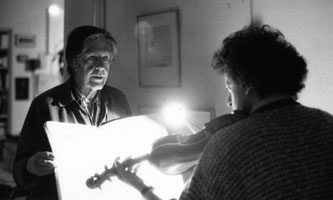CAGE … FREEMAN … ARDITTI: Learning How to Listen by Roger Reynolds Irvine Arditti’s relationship with Cage was a long and crucial one for the composer’s work. Both as a peerless soloist, and as leader of the storied Arditti String Quartet, he collaborated with Cage in significant ways. Foremost among their interactions would have to be the completion and then full realization of the Freeman Etudes, named for the late Los Angeles patroness of the arts, Betty Freeman.
First asked to perform the initial set of Etudes in 1988, Arditti recalls that “meeting the man and working with him was much more dramatic than just the learning of the piece beforehand.” “Obviously the Freeman Etudes is a peak in the contemporary virtuoso violin repertoire. No violinist would arrive in the afternoon of the concert to meet the composer without a thorough preparation … I still had to learn to react and digest what this composer didn’t say rather than what most composers said. It was instruction on how one thinks about the way to do, rather than actually doing ... As we know, Cage was a philosopher as well as composer. Cage taught me how to think generally about situations, not just in music. … [He] was much more interested in the shape of the piece as a whole and the experience of listening. That was his responsibility: to guide and influence the audience. To teach them how to listen, if you like. He was very happy to allow me to make my choices with regard to any technical questions.” Cage began work on a set of Etudes with violinist Paul Zukofsky, at the behest of Freeman, in 1977. Working to create a score that was “as precise as possible” led him to extravagant difficulty, and caused Zukofsky to judge the resulting compositions unplayable. Work on the set ceased in 1980 after Books I and II were completed.
The four books of etudes – 32 in all – comprise one of the most monumental creations yet attempted for string instruments. The Phillips Collection performance for the John Cage Centennial Festival Washington, DC will also include subtle real-time spatialization of the performed sound. This performance will mark the first time that Mr. Arditti has played the complete Freeman set in the US. |
|---|



